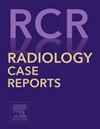Sacral intraosseous schwannoma in an adolescent patient: A case report
Q4 Medicine
引用次数: 0
Abstract
Schwannomas are benign peripheral nerve sheath tumors arising from Schwann cells and, as a result, can occur anywhere in the body. Intraosseous schwannomas are a rare subset of these tumors that are usually found in the medullary cavities of bones. According to the available literature, the sacrum is a common site of involvement within the spine. Affected patients are typically adults older than 20 years of age with no male or female predilection. We present a 17-year-old female athlete with low back pain and radiculopathy. Initial lumbar spine radiographs and magnetic resonance imaging were reported to be negative. Months later, dedicated imaging studies were performed after an abnormality of the sacrum was suspected during medical evaluation for return to sports. A sacral mass was confirmed. Initial and repeat image-guided biopsies confirmed a benign schwannoma. Detection and diagnosis of sacral intraosseous schwannomas present a challenge in the pediatric population given their rare occurrence. Although their imaging features have been described, intraosseous schwannomas are infrequently included in the list of differential diagnoses. Their nonaggressive imaging features should allow interpreting radiologists to narrow the potential diagnoses, thereby helping clinicians arrive at the correct diagnosis more efficiently.
青少年骶骨内神经鞘瘤1例报告
神经鞘瘤是由雪旺细胞引起的良性周围神经鞘肿瘤,因此可以发生在身体的任何部位。骨内神经鞘瘤是这些肿瘤中一个罕见的子集,通常在骨髓腔中发现。根据现有文献,骶骨是脊柱受累的常见部位。受影响的患者通常是20岁以上的成年人,没有男性或女性的偏好。我们提出一个17岁的女运动员腰痛和神经根病。据报道,最初的腰椎x线片和磁共振成像呈阴性。几个月后,在恢复运动的医学评估中怀疑骶骨异常,进行了专门的影像学检查。经确认为骶骨肿块。初步和重复影像引导活检证实为良性神经鞘瘤。骶骨内神经鞘瘤的检测和诊断在儿科人群中是一个挑战,因为它们的罕见发生。尽管其影像学特征已被描述,骨内神经鞘瘤很少被列入鉴别诊断清单。他们的非侵袭性成像特征应该允许解释放射科医生缩小潜在的诊断,从而帮助临床医生更有效地达到正确的诊断。
本文章由计算机程序翻译,如有差异,请以英文原文为准。
求助全文
约1分钟内获得全文
求助全文
来源期刊

Radiology Case Reports
Medicine-Radiology, Nuclear Medicine and Imaging
CiteScore
1.10
自引率
0.00%
发文量
1074
审稿时长
30 days
期刊介绍:
The content of this journal is exclusively case reports that feature diagnostic imaging. Categories in which case reports can be placed include the musculoskeletal system, spine, central nervous system, head and neck, cardiovascular, chest, gastrointestinal, genitourinary, multisystem, pediatric, emergency, women''s imaging, oncologic, normal variants, medical devices, foreign bodies, interventional radiology, nuclear medicine, molecular imaging, ultrasonography, imaging artifacts, forensic, anthropological, and medical-legal. Articles must be well-documented and include a review of the appropriate literature.
 求助内容:
求助内容: 应助结果提醒方式:
应助结果提醒方式:


